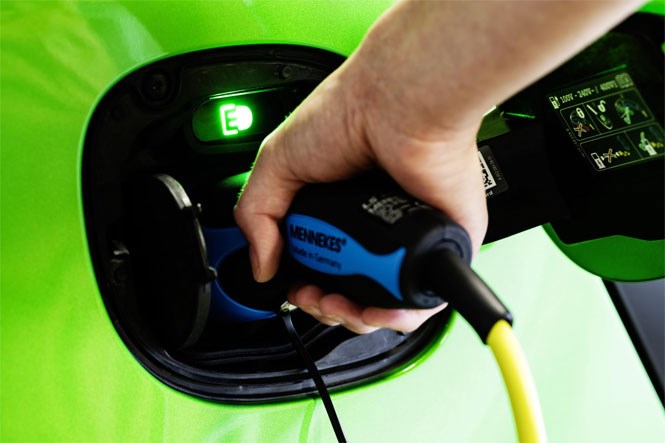The biggest worry for most people when it comes to electric vehicles? How far you can go before you have to find somewhere to recharge them. It’s called range anxiety, and when it comes to electric vans, running out of charge before you’ve got to your destination isn’t just an inconvenience but potentially a major blow to your business.
Now according to a study by vehicle leasing and fleet management company Arval, if you maximise your electric van’s payload, you could see its range plummet to almost half the distance it can achieve unladen.
How was the impact of payload on range tested?
Usually when a company is press releasing a study as a means of promoting its business it’s wise to take the results with a pinch of salt. But Parkers Vans has spoken to Arval’s Commerical Vehicle Consultant Eddie Parker to find out more about how the test was carried out, and it seems to have been undertaken with considerable thought and rigour.
Parker drove the same electric van – which Arval has decided not to name – over a specific 33.58-mile road course at the same time of day on consecutive mornings, testing it when empty, with 25% payload, 50% payload, 75% payload and 100% payload, comparing the amount of driving range remaining at the end of the route. The time taken for every journey was noted, and found to vary by only two minutes.
When unloaded the electric van had used 45% of its potential maximum range by the finish, but when carrying a full payload it had used up “over 85%” of its range. Or to put it another way, the empty van still had 55% of its battery capacity left, the fully loaded one less than 15%.
Arval calculates this means the total range of the vehicle “almost halves” with payload.
How “real world” was the test?
The route chosen was designed to represent “typical van use”, and broken up into sections: 16.8% urban roads, 32.5% surburban/rural, 21.5% carriageway and 29.2% motorway.
The van travelled between 30 and 70mph – so not at a restricted speed – and non-essential electrics including the air-conditioning were switched off.
In order to best represent regular users, no Eco modes were engaged and the van was fully charged before every run using a regular three-pin plug like you’d have at home, rather than a rapid or fast charger of any description.
Arval also chose to discount the van manufacturer’s official maximum range figures, and relied instead upon the specific vehicle’s on-board computer to determine how much battery charge was left in each instance.
How damning is this result for electric vans?
Parker explained: “We undertook the test in response to requests from customers who were looking to gain an operational understanding of this kind of vehicle.”
The results “should not be seen as an indictment of electric commercial vehicles,” he said, rather as a contribution to “a growing pool of knowledge” about what it’s actually like to put them to use.
“The fact is that, in general use, few vans of this type would ever be fully laden. A typical load for most uses would be much nearer the 50% mark, where the loss of range is much less pronounced. For this reason, we believe the study shows that there is a wider application for EVs than may at first have been thought.”
And indeed, most electric vans are bought as urban delivery solutions, because they are quiet, cost-efficient (cost per mile is typically much lower) and produce zero local pollution – something that will become increasingly important as city centres begin to introduce ever more stringent ultra-low emission zones, or even consider banning conventional petrol and diesel engines altogether.
Electric vans are still the future
It’s for these reasons that we’re set to see a significant increase in the number of electric vans on the market in the next few years – with Mercedes and Volkswagen both committed to building new models.
What’s particularly interesting about this new breed, however, is that they will be based on much larger vans – VW is building an electric e-Crafter for 2017, while it seems certain the 2016 Mercedes Vision Van concept previews the next Sprinter, expected in 2018 – whereas most current electric vans are small models, such as the Nissan e-NV200, Renault Kangoo ZE, Citroen Berlingo Electric and Peugeot Partner Electric.
By switching to larger vans, manufacturers will be able to offer vastly increased driving ranges, depending on operator requirements (the larger the battery pack, the further the van will travel but the more it will reduce the van’s overall payload).
Finally, as Parker points out: “All vehicles lose range when fully laden. A diesel van with a full payload would typically see its range reduced by around 35%, for example.” We’ve confirmed that this figure is based on similar trials Arval has undertaken with a diesel equivlanet of the electric van tested in this instance.
This rather suggests to us that battery technology doesn’t need to improve too much before it achieves parity with internal combustion in this regard.
Find electric vans for sale on Parkers by clicking here
Parkers asks: should you be driving an electric van?
Government to invest £7.5m in workplace electric chargers
Trucking electric: British firm Charge reveals electric truck plans
Just so you know, we may receive a commission or other compensation from the links on this website - read why you should trust us.




